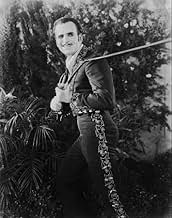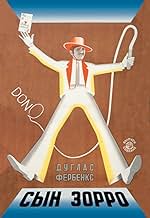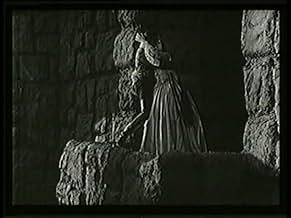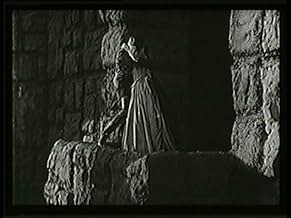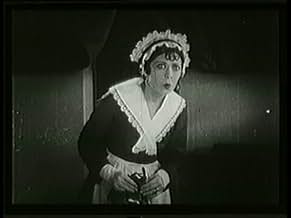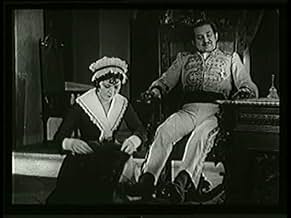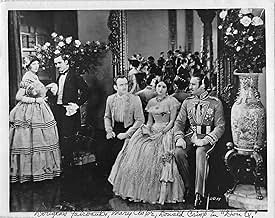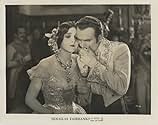Ajouter une intrigue dans votre langueDon Cesar, son of Zorro, is framed for murder while visiting Spain, and becomes the whip-wielding outlaw Don Q.Don Cesar, son of Zorro, is framed for murder while visiting Spain, and becomes the whip-wielding outlaw Don Q.Don Cesar, son of Zorro, is framed for murder while visiting Spain, and becomes the whip-wielding outlaw Don Q.
- Prix
- 3 victoires au total
Stella De Lanti
- Queen Isabella
- (as Stella DeLanti)
Lottie Pickford
- Lola
- (as Lottie Pickford Forrest)
George Blankman
- Undetermined Secondary Role
- (uncredited)
Charles Byer
- Undetermined Secondary Role
- (uncredited)
André Lanoy
- Artist
- (uncredited)
Avis en vedette
Film sequels were a novelty in 1925, when DON Q, SON OF ZORRO marked a big profit for United Artists. Then and now, it is considered to be a better film than the original, THE MARK OF ZORRO (1920), which made star and producer Douglas Fairbanks the personification of the Swashbuckler five years earlier.
Since his screen debut in 1915, Fairbanks had always been cast in contemporary comedies as a fun-loving, never-say-die, go-getter who gets the girl and catches the bad guys all the while exhibiting his athletic prowess and bravado. He was a major film actor, but his popularity was beginning to wane due to the monotony of his roles and vehicles.
The formation of United Artists Corporation in 1919 gave founders Fairbanks, Mary Pickford, Charlie Chaplin and D.W. Griffith control over their own projects. Fairbanks chose this opportunity to risk reinventing his image by starring in this film adaptation of The Curse of Capistrano. The serialized novel written by Johnston McCulley had been published that year in a popular pulp magazine. It introduced the character of Zorro to the world. The magic of the movie assured Zorro's place among fictional super-heroes. The character lived on in several more film versions as well as books, comics, cartoons, Halloween costumes, toys, and in the popular 1950's television series starring Guy Williams.
In THE MARK OF ZORRO, set in early 19th century California, Fairbanks came up with an ingenious concept showcasing his likable contemporary stock character into an action/adventure period costume picture. He plays Don Diego Vega, the milksop son of an affluent rancher who, like the Scarlet Pimpernel, dons a disguise to defend the impoverished townsfolk from the tyrants in power. His alter ego Zorro's, (Spanish for fox) trademarks are the black cape and cowl mask he wears and the master swordsmanship he displays. He is known to brand his victims with a "Z" made with three fast strokes of his blade. At the end of the film, after Zorro's greatest triumph, his identity is revealed. He throws his sword into the air. It lodges into a high spot on the wall, as Zorro shouts, "Till I need you again!" Though it was probably not Fairbanks' intention at the time, this line was a prime set-up for a sequel if there ever was one.
After the tremendous financial and critical success of ZORRO, Fairbanks continued to give the public what it wanted the charismatic Fairbanks persona in lavish period epics. THE THREE MUSKETEERS, ROBIN HOOD and THE THIEF OF BAGDAD were all released in the years between the two Zorro epics.
As one can easily discern by the title of this follow-up, Doug is back as Diego's son - namely Don Cesar, aka "Don Q." The screenplay is based on the novel "Don Q's Love Story" by Hesketh Prichard and Kate Prichard which had no relationship to Zorro at all. But by making Don Q the offspring of the famous hero, it cashed in on the audience's familiarity with the original and made it possible for Doug to play a dual role as both father and son.
In the family tradition, Don Cesar is sent to Spain to continue his education and learn the traditions of his ancestors. His high-spirited ways and showmanship with a bullwhip make him a favorite of the Queen's cousin, Archduke Paul of Austria (Warner Oland). Cesar also makes an enemy of surly Don Sebastian (Donald Crisp), a member of the Queen's guard, and both men fall for the beautiful Dolores de Muro (Mary Astor). After Cesar is framed for murder, he fakes suicide and goes underground until he can prove the guilt of the real killer. Meanwhile, in California, Don Diego receives word of his son's predicament. He retrieves his sword from where it had stuck thirty years before, digs out his mask and cape and travels to Spain to help rescue his son. Father and son take on 15 soldiers in a sword fight during the film's exuberant finale.
Audiences and critics alike loved DON Q even more than the original. Film-making technique and technology had improved rapidly since 1920. The sequel had a stronger plot, higher production values and better pacing. What's more, Fairbanks has fine-tuned his swashbuckler persona to perfection. He was never was he more cocksure, flamboyant and amusing than he appears here. Though already 41 years old, he easily got away with playing a much younger character in no small part due to his physical fitness. He is shown to great advantage, engaging in sword-play, jumping on a horse or his specialty in this film - cracking a whip. Well known for performing his own stunts, Doug reportedly spent six weeks learning fancy whipmanship. He uses it to light a cigarette, extinguish a candle, slice paper, lasso a bull and swing onto a balcony. He also shows himself to be a dandy on the dance floor in a parody of a Valentino tango.
Donald Crisp, best known for his chilling performance as Lillian Gish's cruel father in BROKEN BLOSSOMS, does double duty in DON Q as both co-star and director. He plays Fairbanks' dastardly nemesis Don Sebastian while directing one of his best films. Crisp directed more than 70 films, including the Buster Keaton classic,THE NAVIGATOR. He got his start in the movies in 1908 with the Biograph Company and appeared on screen for the last time 55 years later as Grandpa Spencer in the 1963 film SPENCER'S MOUNTAIN that starred Henry Fonda. Crisp died in 1974.
The New York Times thought so highly of DON Q, SON OF ZORRO, that they named it one the 10 best films of 1925.
While enjoyable on TV or home video, the movie is twice the fun when watched with live accompaniment and an audience as I was fortunate to experience at Cinevent 2006.
Since his screen debut in 1915, Fairbanks had always been cast in contemporary comedies as a fun-loving, never-say-die, go-getter who gets the girl and catches the bad guys all the while exhibiting his athletic prowess and bravado. He was a major film actor, but his popularity was beginning to wane due to the monotony of his roles and vehicles.
The formation of United Artists Corporation in 1919 gave founders Fairbanks, Mary Pickford, Charlie Chaplin and D.W. Griffith control over their own projects. Fairbanks chose this opportunity to risk reinventing his image by starring in this film adaptation of The Curse of Capistrano. The serialized novel written by Johnston McCulley had been published that year in a popular pulp magazine. It introduced the character of Zorro to the world. The magic of the movie assured Zorro's place among fictional super-heroes. The character lived on in several more film versions as well as books, comics, cartoons, Halloween costumes, toys, and in the popular 1950's television series starring Guy Williams.
In THE MARK OF ZORRO, set in early 19th century California, Fairbanks came up with an ingenious concept showcasing his likable contemporary stock character into an action/adventure period costume picture. He plays Don Diego Vega, the milksop son of an affluent rancher who, like the Scarlet Pimpernel, dons a disguise to defend the impoverished townsfolk from the tyrants in power. His alter ego Zorro's, (Spanish for fox) trademarks are the black cape and cowl mask he wears and the master swordsmanship he displays. He is known to brand his victims with a "Z" made with three fast strokes of his blade. At the end of the film, after Zorro's greatest triumph, his identity is revealed. He throws his sword into the air. It lodges into a high spot on the wall, as Zorro shouts, "Till I need you again!" Though it was probably not Fairbanks' intention at the time, this line was a prime set-up for a sequel if there ever was one.
After the tremendous financial and critical success of ZORRO, Fairbanks continued to give the public what it wanted the charismatic Fairbanks persona in lavish period epics. THE THREE MUSKETEERS, ROBIN HOOD and THE THIEF OF BAGDAD were all released in the years between the two Zorro epics.
As one can easily discern by the title of this follow-up, Doug is back as Diego's son - namely Don Cesar, aka "Don Q." The screenplay is based on the novel "Don Q's Love Story" by Hesketh Prichard and Kate Prichard which had no relationship to Zorro at all. But by making Don Q the offspring of the famous hero, it cashed in on the audience's familiarity with the original and made it possible for Doug to play a dual role as both father and son.
In the family tradition, Don Cesar is sent to Spain to continue his education and learn the traditions of his ancestors. His high-spirited ways and showmanship with a bullwhip make him a favorite of the Queen's cousin, Archduke Paul of Austria (Warner Oland). Cesar also makes an enemy of surly Don Sebastian (Donald Crisp), a member of the Queen's guard, and both men fall for the beautiful Dolores de Muro (Mary Astor). After Cesar is framed for murder, he fakes suicide and goes underground until he can prove the guilt of the real killer. Meanwhile, in California, Don Diego receives word of his son's predicament. He retrieves his sword from where it had stuck thirty years before, digs out his mask and cape and travels to Spain to help rescue his son. Father and son take on 15 soldiers in a sword fight during the film's exuberant finale.
Audiences and critics alike loved DON Q even more than the original. Film-making technique and technology had improved rapidly since 1920. The sequel had a stronger plot, higher production values and better pacing. What's more, Fairbanks has fine-tuned his swashbuckler persona to perfection. He was never was he more cocksure, flamboyant and amusing than he appears here. Though already 41 years old, he easily got away with playing a much younger character in no small part due to his physical fitness. He is shown to great advantage, engaging in sword-play, jumping on a horse or his specialty in this film - cracking a whip. Well known for performing his own stunts, Doug reportedly spent six weeks learning fancy whipmanship. He uses it to light a cigarette, extinguish a candle, slice paper, lasso a bull and swing onto a balcony. He also shows himself to be a dandy on the dance floor in a parody of a Valentino tango.
Donald Crisp, best known for his chilling performance as Lillian Gish's cruel father in BROKEN BLOSSOMS, does double duty in DON Q as both co-star and director. He plays Fairbanks' dastardly nemesis Don Sebastian while directing one of his best films. Crisp directed more than 70 films, including the Buster Keaton classic,THE NAVIGATOR. He got his start in the movies in 1908 with the Biograph Company and appeared on screen for the last time 55 years later as Grandpa Spencer in the 1963 film SPENCER'S MOUNTAIN that starred Henry Fonda. Crisp died in 1974.
The New York Times thought so highly of DON Q, SON OF ZORRO, that they named it one the 10 best films of 1925.
While enjoyable on TV or home video, the movie is twice the fun when watched with live accompaniment and an audience as I was fortunate to experience at Cinevent 2006.
Dashing Douglas Fairbanks (as Don Cesar de Vega) is the son of the legendary "Zorro", in this spectacular sequel to Mr. Fairbanks' own "The Mark of Zorro" (1920) *********. The younger Fairbanks has been sent to Spain, where he cracks his whip, and soaks up local color. There, he falls in love with pretty Mary Astor (as Dolores de Muro); watch out for the great introduction to Ms. Astor's character, as Fairbanks places wings on her silhouette. You know trouble is brewing when dastardly rival Donald Crisp (as Don Sebastian) is spurned by "belle of the Archduke's ball" Astor. In a fit of anger, Mr. Crisp assassinates Archduke Paul (as Warner Oland), and frames Fairbanks for the killing. Then, Fairbanks fakes his own suicide, and sets out to prove his innocence; eventually, he receives help from father "Zorro" (Fairbanks, in a dual role).
"Don Q, Son of Zorro" is a tremendous sequel, from Fairbanks and company, who wisely viewed follow-ups as a chance to equal, or improve upon, earlier hits. Not surprisingly, it lacks the spontaneity of the earlier film, and it is, perhaps, a little too long. However, the overall production is superior, and the storyline refreshingly unique; as "Don Q", and his story, are quite different than the original "Zorro". Crisp is very helpful, as both villain and director. And, Henry Sharp's photography is top notch.
The cast is terrific: alongside the aforementioned, you have Fairbanks regular Charles Stevens (as Robledo) in one of his more showy roles, otherwise humanitarian Jean Hersholt (as Don Fabrique) playing Crisp's blackmailing nemesis, famous sibling Lottie Pickford (as Lola), and Albert MacQuarrie (as Colonel Matsado) gets to ask Fairbanks: "Who the hell are you?"
"Don Q, Son of Zorro" is a tremendous sequel, from Fairbanks and company, who wisely viewed follow-ups as a chance to equal, or improve upon, earlier hits. Not surprisingly, it lacks the spontaneity of the earlier film, and it is, perhaps, a little too long. However, the overall production is superior, and the storyline refreshingly unique; as "Don Q", and his story, are quite different than the original "Zorro". Crisp is very helpful, as both villain and director. And, Henry Sharp's photography is top notch.
The cast is terrific: alongside the aforementioned, you have Fairbanks regular Charles Stevens (as Robledo) in one of his more showy roles, otherwise humanitarian Jean Hersholt (as Don Fabrique) playing Crisp's blackmailing nemesis, famous sibling Lottie Pickford (as Lola), and Albert MacQuarrie (as Colonel Matsado) gets to ask Fairbanks: "Who the hell are you?"
After his artsy fantasy "The Thief of Baghdad" freaked everyone out, Doug got back to basics with this sequel to his first swashbuckler, "The Mark of Zorro" -- and concocted a meticulously designed, take-no-chances star vehicle. The sets, cast, and screenplay are all impressive but, as always, it's the Fairbanks persona -- an odd combination of pragmatist and dreamer, magician and acrobat, lover and fighter, rogue and moralist -- and his endless bag of tricks, gags, and stunts that sets the film apart from, not only 1920s action spectacles, but those of his successors: Jackie Chan, James Bond, and Indiana Jones.
Of his later pictures, perhaps only "The Gaucho" tops this one for sheer excellence in filmmaking.
Of his later pictures, perhaps only "The Gaucho" tops this one for sheer excellence in filmmaking.
As an early Zorro movie, well, an early movie period, this was fairly good. I will admit that some of it was kind of dumb. The plot is that Zorro's son has been framed for a murder. This happens because someone forges the murder victim's signature saying he was the killer. How could anyone be fooled into thinking someone wrote down who their murderer was? Was this a thing back in the 1920's? The Zorro costume does in fact appear, but unfortunately it's only in the last ten minutes. With all that being said, this still is by no means a bad movie. The original Zorro movie was better.
While this was before color, I really was impressed by the tints of this movie. I guess they don't count as colors, but this really was a nice looking movie. The atmosphere is probably the strongest point, because this is a movie that's very nice to look at with great sets. It's so nice to see how well they hold up after nearly a hundred years! I like the idea of Zorro having a son, but this was interesting because he wasn't just taking on the persona of Zorro. He really was becoming a new character in his own right. Sequels shouldn't just repeat what the original did. It's great to point out the flaws in such an old movie. While not a classic, it's fine. ***
While this was before color, I really was impressed by the tints of this movie. I guess they don't count as colors, but this really was a nice looking movie. The atmosphere is probably the strongest point, because this is a movie that's very nice to look at with great sets. It's so nice to see how well they hold up after nearly a hundred years! I like the idea of Zorro having a son, but this was interesting because he wasn't just taking on the persona of Zorro. He really was becoming a new character in his own right. Sequels shouldn't just repeat what the original did. It's great to point out the flaws in such an old movie. While not a classic, it's fine. ***
The Mark of Zorro to me is one of the Douglas Fairbanks classics, and its sequel Don Q Son of Zorro is just as great and even on par with it. It looks spectacular with sets that look lavish and expensive and photography that positively sweeps. The music score rouses the spirits well enough and there is a sense of humour that has a strong presence and in a way that is still fresh. The story is well-paced and compelling with thrills, fun and adventure galore. It's conventional for a film starring Fairbanks and as an adventure film as well in a sense but not to a routine or simplistic degree, it is always easy to follow and still offers enough surprises. The action is full of energy and rousingly choreographed, never too much or too little and they move the story forward rather than slowing down. If you are looking for stunts that will leave you in awe, as you often find in Fairbanks's films, you will not be disappointed in Don Q Son of Zorro, they're unmistakably Fairbanks but don't feel rehashed. Donald Crisp directs with a deft and imaginative touch, and the characterisations are vivid enough, with the exception of Mary Astor who doesn't have a lot to do and comes across as bland as a result(shame as she has done a fair amount of stuff that I like). Crisp is especially good in support, he has rarely been more malevolent though not in a blatant way, and Don Sebastian is easily one of the nastiest villains of any Fairbanks film. Warner Oland is solid too if occasionally resorting to histrionics. Douglas Fairbanks is the most impressive though, the athletic stunts look so effortless when he does them and the gallant charisma and infectious smile makes him a most likable hero. To conclude, Mark of Zorro is still a classic and one of Fairbanks' greatest but Don Q Son of Zorro is just as great. 9/10 Bethany Cox
Le saviez-vous
- AnecdotesDanish composer Jacob Gade's internationally famous piece "Tango Jalousi" was composed for the Danish gala premiere of this film, which took place 14 September 1925 in Palads Teatret, Copenhagen.
- Citations
Don Cesar de Vega: My father always said, "When you are in the right, fight; when you are in the wrong, acknowledge it."
- ConnexionsFeatured in Sprockets: Cliffhangers (1995)
Meilleurs choix
Connectez-vous pour évaluer et surveiller les recommandations personnalisées
Détails
- Date de sortie
- Pays d’origine
- Langue
- Aussi connu sous le nom de
- El hijo del Zorro
- Lieux de tournage
- société de production
- Consultez plus de crédits d'entreprise sur IMDbPro
- Durée1 heure 51 minutes
- Mixage
- Rapport de forme
- 1.33 : 1
Contribuer à cette page
Suggérer une modification ou ajouter du contenu manquant

Lacune principale
By what name was Don Q Son of Zorro (1925) officially released in Canada in English?
Répondre

